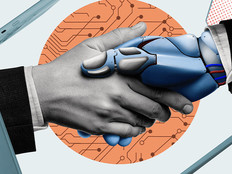More than other industries, retail brands are moving aggressively forward with a range of artificial intelligence projects — and leaders are talking at length about how they’re deploying the technology at NRF 2020 Vision: Retail’s Big Show in New York.
One example: FULLBEAUTY Brands, an online clothier for plus-size women and men, is developing new approaches to how it handles data — a big step for a company that began a century ago as a catalog company, said Christiane Pendarvis, FULLBEAUTY’s senior vice president for e-commerce.
“We’ve always had a wealth of data about our customers, but over 100 years, our business has transformed,” she said Sunday during a panel titled “The Age of AI: Women Shaping the Future of Retail.” “Today, we’re bringing all of our data together out of different silos and into a single unified view. So, it’s more than just, ‘If you bought this product, we’re going to show you other things in that category,’ but rather that we’re going to take a holistic view of the interactions you’ve had with our company.”
Seemantini Godbole, CIO of home improvement chain Lowe’s, said that while AI is indeed playing a vital role inside most retail brands today, they are still at the beginning of discovering its value.
“AI at scale is going to take its time,” Godbole said. “Just like every technology, AI needs time to mature and needs time for more complex use cases.”
MORE FROM NRF: Microsoft's CEO declares era of "tech intensity" for retailers.
PetSmart Combines AI with Indoor Location Tech
PetSmart is testing an AI application that combines advanced analytics with indoor location technology. During a separate session, Dave Caldwell, PetSmart’s vice president of IT service delivery, explained that as the company has deployed improved in-store Wi-Fi throughout its more than 1,500 North American locations, it has been thinking through different ways to capitalize on it to deliver better customer experiences.
“We’re trying to figure out how to appropriately interact with customers inside our stores,” he explained. “There are all kinds of signals that customers send while they’re in the store.”
Not long ago, retailers barely knew who their customers were. Today, thanks to loyalty programs and e-commerce, they know a lot more. But imagine knowing in real time not only that a particular customer has entered the store but where exactly in the store that customer is and what they’re looking at — then combining that information with what the retailer already knows to draw intelligent conclusions and take action.
“Maybe you’re walking into our services area and we can tell in real time whether you’re a services customer or not,” Caldwell said. If not, would it be appropriate notify an associate to approach you to ask if you’d like to learn about, say, grooming? Or suppose a known cat owner is browsing the puppy food aisle. That’s a customer who might benefit from a new puppy starter kit, so maybe an employee should suggest it.
In addition to AI-driven data analytics, indoor location technology is necessary for that kind of interaction, noted Bob Friday, CTO of Mist Systems, a Wi-Fi enablement company owned by Juniper Networks. Friday said retailers have been somewhat slow to adopt indoor location, but that’s changing. “I think we’re on the verge of watching indoor location go from something that’s nice to have to a must-have technology for retailers,” he said.
Retailers Grapple with the Ethics of AI
Even as they’ve been more aggressive in adopting AI than most other industries, retailers are proceeding with some caution as they think through customer reactions to certain applications, as well as the ethics of AI.
For example, AI applications have been known to replicate the very same unconscious biases that the humans programming them have. Retailers will have to be careful about ensuring their applications are free of those biases, argued Pendarvis.
“AI is only as good as the inputs that go into the programming,” she said. “And if we institutionalize the natural unconscious biases that we have as humans and build them into our technology, there’s a huge risk. It can make those biases seem objective.
Keep this page bookmarked for articles and videos from the event. Follow us on Twitter at @BizTechMagazine, or the official conference Twitter account, @NRFBigShow, and join the conversation using the hashtag #NRF2020.










